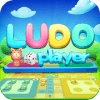手机游戏> Ludo of Friendship> 游戏新闻
Ludo of Friendship

Ludo is a popular board game derived from an ancient Indian game called Pachisi. It is a fun, family-friendly board game played with 2-4 people. It is easy to understand, but has some complex rules. The goal of the game is to get all your pawns inside the home pocket, which is located in the middle of the board. The Ludo board has a combination of typical colors bright yellow, green, red, and blue. Each player chooses a color and has four tokens/pieces of his/her corresponding color. Game play : There are several terms specific to Ludo and other similar games. Each player picks a color and is control of the four pieces, or pawns. Instead of using a pair of dice, Ludo only requires one die. The game begins by setting up each pawn in their corresponding pockets. Pockets are the big, color-coated squares in each corner. The home pocket is the center square that has one space of each color. Most of the game play occurs on the track. The track consists of 52 spaces. The home run is made of four sets of five spaces. This stretch leads into the home pocket. You can only be on the home run if your pawn’s color matches the color of the home run. Movement : To begin, a player must roll a six to move a piece out of the base and onto the starting square. That piece is then in play. The player cannot make any other moves until at least one piece is in play. If a player has a piece or pieces in play, they can move any one of their pieces 1 to 6 squares along the path according to the number they roll. Rules : - Each player gets a chance to roll the die, the highest roller (the one who gets the 6) begins the game. The other players start rolling the die in a clockwise direction. - To enter a token/piece into play,or from its staging area to its starting square, a player must roll a 6. If the player does not roll a 6, the turn passes to the next player. Once a player has one or more tokens in play, he can choose any one of the tokens in play and move them forward. The number on the rolled die will determine the number of squares the chosen piece moves forward. - Prevents players from returning opponent pieces to the starting area. When we land on an opponent's pawn, the pawn will be pushed forward one square until it lands on a free space.



 粤公网安备44010602000283号
粤公网安备44010602000283号
